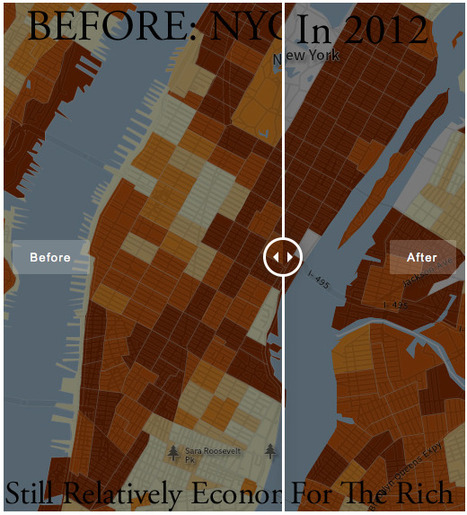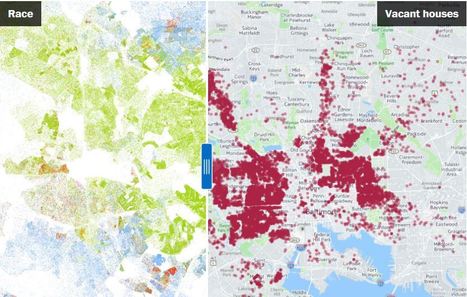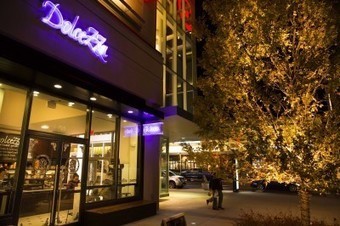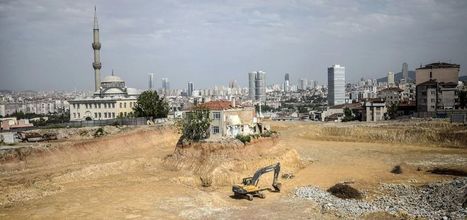Get Started for FREE
Sign up with Facebook Sign up with X
I don't have a Facebook or a X account
 Your new post is loading... Your new post is loading...
 Your new post is loading... Your new post is loading...

Dustin Fowler's curator insight,
May 4, 2016 8:42 PM
Pros and Cons of Gentrification- a brief synopsis.
Kendra King's curator insight,
April 3, 2015 7:39 PM
Normally I am annoyed at projects that end up destroying history, but in this instance I think the area needs to be remodeled. Part of the reason I am not fazed by the history being lost is because a fair amount of the area was already so poorly kept that many of the structures were either ruble or dilapidated. At the rate the area was going, it was already going to lose its history anyways. While it would be nice of the government to keep a small portion of the good standing landscape, I think the museum being built in the area is a nod at maintaining there history. So since you can’t have it all, I would rather side with the government trying to raise the standard of living for people who have been in continuous abject poverty since about the 13th century. As you said before, invest something in an area and you typically get something in return. Plus it seems that most of the people angered by this move are those outside of the area being remodeled (i.e. historians). I personally think those people are farther removed from the actual decision then those living there. So once again, I am happy to side with the people being most affected by the poverty stricken land.
Felix Ramos Jr.'s curator insight,
May 6, 2015 10:27 AM
As a man who graduated with a Bachelor's degree in History, it goes without saying that this causes me sadness. But even taking the history component out of the picture, this reformation project is also destroying much of that area's culture and identity. They are risking the few details that remain of their culture's past in order to move the area onto a more global scale. Another negative is the fact that they are picking up the poverty-stricken residents of this community and shipping them to another part of town like they are pieces of livestock. |

Mr Mac's curator insight,
July 6, 2017 8:16 AM
Unit 7 - Gentrifications - specifically addressing "generalizations about Gentrification."

Deanna Wiist's curator insight,
September 12, 2017 9:01 PM
This post will need many disclaimers, but I think that it is a valuable addition to our gentrification materials since the key take-home point is that gentrification doesn’t happen the same way in all places (geographic context matters!). Some of the generalizations about gentrification around the country might not apply to some specific examples. Are these generalizations true in some (and possibly most) contexts? Sure, but unfortunately once people hear the word gentrification, they assume a base set of assumptions about the situation which may or may not be true. The 5 myths outlined in this video (more detail in this Washington Post article) are:
Tags: neighborhood, gentrification, urban, place, culture, economic.
Alexandra Piggott's curator insight,
January 31, 2017 9:06 PM
Another example of spatial exclusion due to income possibly
Hailey Austin's curator insight,
May 11, 2017 2:34 PM
This is related to what I'm learning in class because its talking about urbanization. It talks about how a man visits a very run down place and invest in fixing it up a bit. He rebuilt a house/building. It made the city look better. My opinion on the article is that its a very good deed. Bringing a city back to life is a wonderful thing.
Harley Bass's curator insight,
May 11, 2017 2:35 PM
This connects to are lesson on chapter thirteen through gentrification. My opinion on this video is that gentrification in this neighborhood is good because it is bringing life back to its local community. Gentrification can be a bad thing in some neighborhoods though because it can force poor families out of their home.
kyleigh hall's curator insight,
May 12, 2017 11:21 PM
This article is about a person who bought a house in the suburb areas of New York. He put certain things in his house that is all historically or better for the world. This relates to what we are learning in world cultural geography because we are learning about the suburbs area and inner city areas of places. In my opinion it related to what we learned about a lot also I liked what he did with the stuff he used.
Lauren Quincy's curator insight,
May 24, 2015 9:14 PM
Unit 7: Cities and Urban Land Use
This article is about Sandtown, Baltimore and its shift into a disamenity sector. It explains how this neighborhood, mainly housed by blacks, had a high percentage of vacant houses. The article says that this neighborhood is overrun with poverty, war on drugs and gangs and has the more residents in jail than any other neighborhood. This shows the changing demographics of the city of Baltimore.
This relates to unit 7 because it covers the topic of disamenity sectors and changing demographics. It shows reasons for the high levels of poverty and abandoned housing. It also shows the racial spatial distribution of the neighborhood and its correlation to housing and development. 
Lydia Tsao's curator insight,
May 26, 2015 1:46 AM
This article left me heart broken. The African American community in Baltimore is stuck in a deep poverty cycle, and it cannot seem to escape its impoverished past. Even now, the poverty in the area seems to just be getting worse. The problems of income disparity lead to more problems than just economic; they lead to social and political problems. Social unrest and injustice occurs as a result of the modern white flight. This article arose as a result of the death of Freddie Gray, whose death demonstrates a significant social issue that needs to be addressed: police brutality and the criminal targeting of the African American community. His death stems from the tremendously amounts of disparity in the city. Promoting investment in the inner city would definitely help alleviate the poverty in the area. The problem is getting people to invest.
Evan Margiotta's curator insight,
March 19, 2015 4:18 PM
Gentrification is an interesting concept. Here in Austin we are seeing these signs all over the city. In a growing cities with growing economies the outskirts of the cities are being built up and expanding to allow for their growth. Gentrification is a very common event today, especially in places like Austin with thriving economies. However it often displaces a lot of the population with roots in that area. Its often considered a controversial topic, but is rarely talked about because of it complexity and the fact that it is often viewed as a very good thing. Unit 2 Population
Emily Bian's curator insight,
March 22, 2015 8:48 PM
7) Uneven development, zones of abandonment, disamenity, and gentrification This article was written by a woman who noticed a lot of changes in Washington D.C. Gentrification led to these many changes, by becoming not as unique and urbanizing at other people's expense. She describes gentrification as remodeling very quickly and ferociously. A lot of the things she says are for the general good of the people, like installing street lights, but don't take into consideration the people who don't appreciate the changes. Stores like walmart are taking over the family owned stores, and more people are moving in. This article describes gentrification perfectly, and I like her pictures to go along with it. I think this would help introduce this vocab term to new students. 
Lydia Tsao's curator insight,
March 24, 2015 12:29 AM
Sadly, gentrification happens all across the world. Poor populations in cities are disadvantaged and often have to move out due to wealthier populations moving in. One of the signs I found most disturbing was that police will start patrolling the areas where wealthier and poorer populations mix. This is a sad reality. Police do this to ensure that crime rates are low as poor people would be more tempted to commit crimes in wealthier neighborhoods. I do think this police patrolling has racist roots since the poorer population in Washington D.C. is mostly black. Words like "renewal" and "redevelopment" hide the sad reality behind gentrification/
Amber Coleman's curator insight,
May 11, 2017 10:59 AM
This article relates to my class because we have just discussed the idea of gentrification. I understood that gentrification was the immigration of richer people to poorer areas, but I didn't realize that it was to the point that people would completely loose their homes. However, I know that it is happening because of urbanization.
Lucas Olive's curator insight,
May 11, 2017 2:38 PM
This article relates to what we have been learning in class because this article explains what gentrification is, which is a big part of urbanization. My opinion on gentrification is that it is not good for most people in the area that is being gentrified, it's only good for a few people, usually they're rich.
Kassie Geiger's curator insight,
May 12, 2017 11:50 PM
Gentrification is the process of converting an urban neighborhood from a predominantly low-income, renter-occupied area to a predominantly middle-class, owner-occupied area. To be completely honest I can see how gentrification can be a good thing and a bad thing. The bad part about it is that people could be possibly moving out of a childhood home or a home with sentimental value. While on the other hand it could be a good thing by building new more modern housing that could check the boxes of people "needs" when they are looking to buy a house, especially first-time buyers. They may want a house with a up-to-date kitchen, 4 or 5 bedrooms, an up-to-date bath or two. I can totally understand that to get things how you want them to be in an older house can be extremely difficult and costly. However, some people may want an older house to pass onto their children, to grow old in.
That's pretty much all I have to say about gentrification without going completely off topic.

Molly McComb's curator insight,
March 21, 2015 4:16 PM
New York is such a diverse city that it changes constantly, but in this moment it is now becoming a hub for condos and botiques. Two photographers have set out to take several pictures throughout the city to help preserve some of its classical elements. |




























